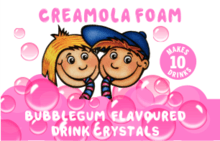Creamola Foam
Creamola Foam was a soft drink produced in the form of soluble crystals. It was manufactured in Glasgow and sold mainly in Scotland from the 1950s until Nestlé ended production in October 1998.
 | |
| Country of origin | Scotland |
|---|---|
| Introduced | 1950 |
In 2005, Allan McCandlish of Cardross started producing a re-creation of Creamola Foam under the name Kramola Fizz.
In April 2019 his daughter Agnes and son Andrew of McCandlish Farmhouse Confectionery relaunched the product under its rightful name of Creamola Foam (registered Trademark) and is now available on the shelves again in Scotland as well as worldwide.
An alternative product called Krakatoa Foam was manufactured by Ally Bally Bees Ltd, based in Fife who went into liquidation in 2014.
Details
Creamola foam came in the form of colourful crystals which were dissolved in cold water to form a sweet, effervescent drink. It was packaged in a small tin labelled with a cartoon girl and boy drinking with straws.
The drink originally came in raspberry, orange, and lemon flavours; cola was a later addition to the range.
The product was originally owned by Rowntrees before coming under the banner of Nestle UK until being sold off to Premier Foods.
The relaunched Creamola Foam drink comes in 17 flavours including the original flavours of raspberry, orange, lemon and cola flavours.
Early form
The original packaging consisted of a small tin with a tight metal lid, normally pried off with a teaspoon. A paper seal covered the foam crystals.
The packaging included the phrases:
- "CREAMOLA FOAM CRYSTALS"
- "MAKES 10 BIG DRINKS"
- "FULLY SWEETENED"
The original ingredient list read:
- Sugar
- Fruit acids
- Sodium bicarbonate
- Gum acacia, a thickener/stabiliser
- Saccharin
- Saponin, a foaming agent
- flavouring
- colour
Later revision
The revision introduced in the 1980s featured a plastic lid and modernised branding. The label reads, "Creamola FOAM". The ingredients were:
- Sugar
- Citric acid
- Sodium bicarbonate
- Tartaric acid
- Flavouring
- Saccharin, sweetener
- Gum acacia, stabiliser
- Extract of quillaia, a foaming agent
- Carmine, food colouring agent (in this example, raspberry flavour)
The effervescence, when the powder dissolves as it is stirred into water, is due to the reaction of the citric and tartaric acids with sodium bicarbonate, forming carbon dioxide gas. These weak organic "fruit" acids also provide the sharp taste. The addition of stabiliser and saponaceous foaming agent extends the life of the bubbles. The artificial colouring and flavouring, plus the fruit acids, give the illusion of a fruity base, although the recipe is essentially synthetic.
See also
- Fizzies, a similar drink in the US.
External links
- Picture of two creamola foam promotional badges